 Is your violin, viola, cello, or bass rattling or buzzing? Does it make these noises only on certain strings or notes?
Is your violin, viola, cello, or bass rattling or buzzing? Does it make these noises only on certain strings or notes?
Just like unwanted noise from your car or truck, rattling or buzzing from your stringed instrument is unsettling. If you’re wondering “Why is my violin buzzing” or “Why is my viola buzzing” or “Why does my cello sound scratchy” - you get the drift - it’s time to take stock of the situation, regardless of the type of fine stringed instrument you’re facing issues with.
First and foremost, the good news for string players is that even if your stringed instrument is buzzing and rattling, it rarely indicates the need for costly repairs; many common rattles and buzzes can be fixed in seconds. Though, in some instances it may mean your instrument will need a short vacation stay at the repair shop. In any case, looking for the easy fixes first may avoid the drive to the repair shop, and should have you back to uninterrupted playing in no time. If you’re stringed instrument is buzzing or rattling, here is a list of troubleshooting your instrument to identify some common causes of buzzes and rattles.
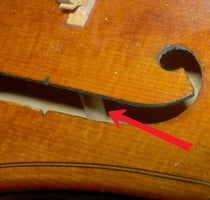 1. Make sure your soundpost is in place! The one cause of rattles (and usually terrible tone quality) that could put your instrument at severe risk is that of a fallen soundpost. Look in the treble f-hole of the instrument and make sure that the soundpost is in its proper spot. It should be just a short distance from the bridge, toward the tailpiece, and approximately directly under the highest string. If it is fallen or is way out of place, tune down the strings slightly to where they are low in pitch but still hold tension, and get the instrument to a luthier.
1. Make sure your soundpost is in place! The one cause of rattles (and usually terrible tone quality) that could put your instrument at severe risk is that of a fallen soundpost. Look in the treble f-hole of the instrument and make sure that the soundpost is in its proper spot. It should be just a short distance from the bridge, toward the tailpiece, and approximately directly under the highest string. If it is fallen or is way out of place, tune down the strings slightly to where they are low in pitch but still hold tension, and get the instrument to a luthier.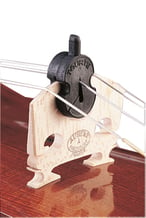
2. Remove any mutes. Muting may not seem like the obvious cause for the buzzing and rattling of a stringed instrument. But surprisingly it can be. The reason for this is that some mutes, like the tourte or slide-on mute, rest on the afterlength of the strings when not in use. These can cause rattling or dampening even when all the way back by the tailpiece. The Bech magnetic mute reduces this phenomenon by holding the mute in place when not in use. If you don't need the mute during a performance, rehearsal, or practice session, is usually safest just to remove it from the instrument entirely.

3. Look for string spacers or defective strings. Some Violin E-strings have a tiny plasic tube called a string spacer that is meant to go around the string where it rests on the bridge to prevent cutting into softer bridges. These are not necessary if your bridge has parchment or an ebony inlay, but can still be used anyway. If they are not held in place by the bridge, they might cause odd noises and vibrations or in other words, the buzzing or rattling of a stringed instrument. Similar vibrations can occur if a string is false, has unraveled winding, or needs to be replaced.
4. Inspect the chinrest. Most chinrests have barrel clamps, whether they are independent (like the Hill Clamp), or connected (standard). These barrels need to be kept snugly tight, which is best accomplished by a chinrest tightener. If they come loose, it can lead to your stringed instrument buzzing and rattling - especially rattling when playing low notes. Lastly, make sure that the chinrest is only contacting the instrument where there is cork or padding. If the metal clamp is close to the ribs, or if the underside of the chinrest is too close to the top plate, you may get occasional buzzing.
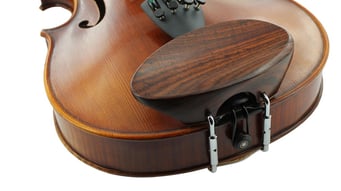
5. Inspect the shoulder rest. Some shoulder rests have screws or parts that can rattle if loose. Try playing without the shoulder rest. If the noise stops, make sure to tighten or replace loose parts on the shoulder rest.
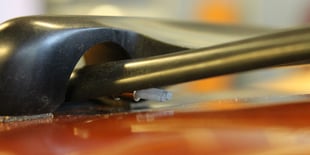 6. See if there is excessive tailgut under the tailpiece. The tailgut (or tailpiece adjuster) is the cord that connects the tailpiece to the endpin button, and holds mostly all of the tension from the strings. Some tailguts are tied, and others are threaded with small brass nuts holding them to the tailpiece. Excess tailgut after the nuts or the knots can rattle against the tailpiece. These can rarely be trimmed without removing the tailpiece, but a piece of tape might hold them still until the instrument can be brought to a luthier.
6. See if there is excessive tailgut under the tailpiece. The tailgut (or tailpiece adjuster) is the cord that connects the tailpiece to the endpin button, and holds mostly all of the tension from the strings. Some tailguts are tied, and others are threaded with small brass nuts holding them to the tailpiece. Excess tailgut after the nuts or the knots can rattle against the tailpiece. These can rarely be trimmed without removing the tailpiece, but a piece of tape might hold them still until the instrument can be brought to a luthier.
7. Check Fine Tuners (string adjusters). If a fine tuner tuned down as far as it goes, the screw can rattle around. Also, most fine tuners are held onto the tailpiece by a small nut, which if loose, can also rattle. These are usually noticeable by a high-pitched rattle, especially on one string.

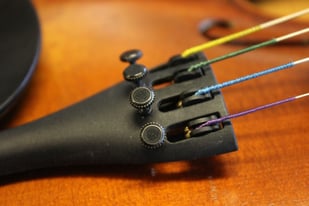
8. Does the buzz only happen on open strings? If a string buzzes when played open, especially when plucked, this is likely due to a low nut or high fingerboard near the nut, the small grooved piece of ebony or bone that holds up the strings at the top of the fingerboard. This will need the attention and opinion of a skilled luthier to address, be it viola open strings or open strings of any other stringed instrument.

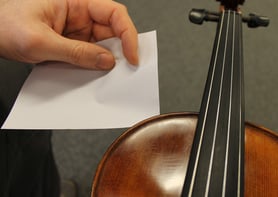 9. Look for open seams. Why is my cello or viola buzzing? It could be attributed to open seams! The top and back plates of violins, violas, cellos, and basses are glued to the ribs with a very specific type of hide-glue. The characteristics of this glue allows for the instrument to resonate well and to be disassembled, but it also makes these seams susceptible to opening up from changes in temperature or humidity. An open seam is not a terribly big deal, you will simply need to bring the instrument to a luthier for repair. To look for open seams, you can trace around each seam with a thin piece of paper, until the paper slips into the seam, revealing it.
9. Look for open seams. Why is my cello or viola buzzing? It could be attributed to open seams! The top and back plates of violins, violas, cellos, and basses are glued to the ribs with a very specific type of hide-glue. The characteristics of this glue allows for the instrument to resonate well and to be disassembled, but it also makes these seams susceptible to opening up from changes in temperature or humidity. An open seam is not a terribly big deal, you will simply need to bring the instrument to a luthier for repair. To look for open seams, you can trace around each seam with a thin piece of paper, until the paper slips into the seam, revealing it.
10. Give your instrument a light shake. Isyour stringed instrument buzzing and rattling because there is something in it? If you can remove the piece by simply turning the instrument over and letting it fall from the f-hole, that is best. If you can't see the object or if it is sizeable, it may be better to bring the instrument to a luthier. Never vigorously shake your instrument!
11. There are other possible causes for unwanted rattling or buzzing of a stringed instrument, be it the violin - the highest pitched stringed instrument - or any other. These simply can't be detected but by a trained luthier. If none of the above solutions work for you, bring your instrument to a luthier or repair shop.
Thank you for reading, and please subscribe to receive updates on our blog!



